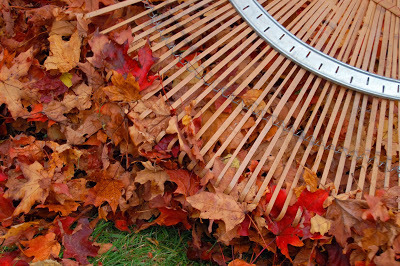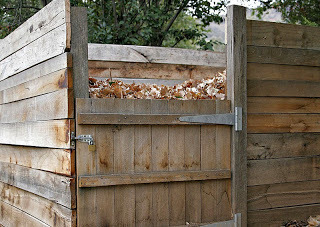Got Fall Leaves? Here's What to Do With Them!
 Every year, I'm amazed that my neighbors rake the leaves off their lawn and put them in neat (initially, anyway) piles along the street for the city to pick up. Don't they know what a gold mine they are throwing away?! Apparently not. But you, my dear readers, have no such excuse. Because, if you don't know how useful fall leaves are already, you're about to learn!
Every year, I'm amazed that my neighbors rake the leaves off their lawn and put them in neat (initially, anyway) piles along the street for the city to pick up. Don't they know what a gold mine they are throwing away?! Apparently not. But you, my dear readers, have no such excuse. Because, if you don't know how useful fall leaves are already, you're about to learn!* Add them in layers to your compost bin. Leaves are one of nature's great plant foods. However, it's important to not dump a huge pile of leaves into the compost bin all all once; they will become slimy mush and will slow down decomposition in the compost pile. So add a layer of leaves, then a layer of "green" (nitrogen-rich) things, like kitchen waste, then another layer of leaves, and so on. Shredding the leaves first speeds up their decomposition. (Running the lawn mower over them will shred them nicely.)
* Use them as mulch. Ideally, shred the leaves first, then place a few inches of the leaf mulch around your plants, keeping the leaves a couple inches away from the stems. Often, though, I don't bother to shred them; we get a lot of winter rain, so that keeps the leaves from blowing around. By spring, even unshredded leaves will be decomposed (or nearly so). Not only do the rotting leaves feed the soil, but they help prevent weeds while retaining moisture in the soil.
* Throw them in the garden bed. If you have any bare garden beds, sprinkle fall leaves over them, then lightly dig them in. The leaves will rot over winter, feeding the soil and encouraging good-for-your-garden worms and micro-organisms. Just don't add huge quantities that will stick together and be slow to decompose.
 * Make leafmold. Yes, you can buy it - but why buy it when you can make it for next to nothing? Leafmold is a rich compost that builds up nutrients in the garden - but it is, after all, just rotten leaves. To make your own, just devote a compost bin to fall leaves. Or fill a plastic bag (black contractor's bags work best) about three-quarters full. Close the bag securely and poke small holes all over the bag. In a year or two, you'll have leafmold.
* Make leafmold. Yes, you can buy it - but why buy it when you can make it for next to nothing? Leafmold is a rich compost that builds up nutrients in the garden - but it is, after all, just rotten leaves. To make your own, just devote a compost bin to fall leaves. Or fill a plastic bag (black contractor's bags work best) about three-quarters full. Close the bag securely and poke small holes all over the bag. In a year or two, you'll have leafmold.* Use them for overwintering. If you are overwintering vegetables like carrots, parsnips, and leeks in a raised bed or under a tunnel, placing fall leaves over them will keep them sufficiently warm in most climates. If you get snow, you'll need to completely cover your overwintered crops with leaves, then add at least another foot of leaves on top. In climates where there's just a spinkling of snow, just a few inches of leaves is usually all that's required. Leaves for overwintering don't work well if you don't have a raised bed or something else to hold the leaves in place.
* Start a lasagna garden. This is a simple way to turn bad gardening soil into spectacular growing soil - and one main ingredient is leaves. Essentially, you're just layering "greens" (nitrogen rich materials) and "browns" (carbon rich materials) on top of the soil; you'll need about twice as many browns as greens, and you should stack everything two or three feet high. Read more about lasagna gardening here.
Not all leaves are created equal. Some are quicker to decompose than others, and some add more nutrients to the soil than others. Thick leaves (like holly leaves) must be well shredded before you can use them in the garden. And Eucaliptus, walnut, and camphor and cherry laurel leaves actually inhibit plant growth, so they shouldn't be used at all.
But leaves left on the lawn will kill it - and there's no reason to throw leaves away if they can make your garden more productive. Give it a try!
Published on October 29, 2013 07:00
No comments have been added yet.



